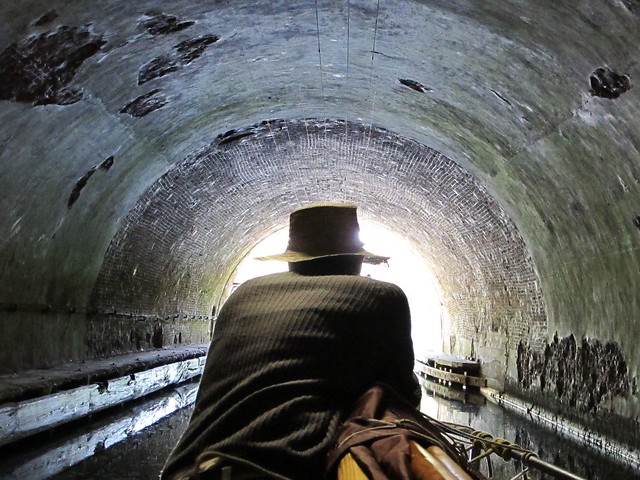
Our journey keeps moving at a fastly slow pace. We cover an average of 30km per day.
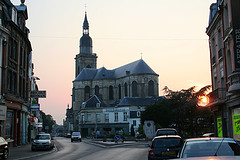 We left our story in Cambrai, on the Canal De Saint Quentin: The city is nice and rich in history. Funnily enough, here in 1508 Pope Julius II created the League of Cambrai, an alliance between the greatest european powers of the time against Venice, my adoptive city. Too many cooks spoiled the broth and the League faded like snow under the sun, with intrigues and sudden changes in alliances.
We left our story in Cambrai, on the Canal De Saint Quentin: The city is nice and rich in history. Funnily enough, here in 1508 Pope Julius II created the League of Cambrai, an alliance between the greatest european powers of the time against Venice, my adoptive city. Too many cooks spoiled the broth and the League faded like snow under the sun, with intrigues and sudden changes in alliances.
Whilst our companions set sails, Fine and I stay in Cambrai to update the website, a very difficult task now because there are very few villages along the canals. We agree with Bruno, Francesco and Sandro to meet again in the evening, just before the Riqueval tunnel.
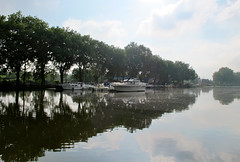 Thanksfully we manage to get a lift by a very kind friend, met the night before in the beautiful Port of Cambrai, where Captain Jean Luc granted us free mooring. Julien Debut, that’s his name, is very helpful and takes us to the meeting point just after work (in an italian pizzeria, by the way).
Thanksfully we manage to get a lift by a very kind friend, met the night before in the beautiful Port of Cambrai, where Captain Jean Luc granted us free mooring. Julien Debut, that’s his name, is very helpful and takes us to the meeting point just after work (in an italian pizzeria, by the way).
Our deepest thanks to him.
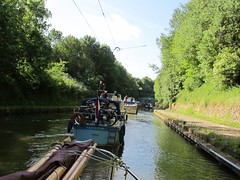 In these days we get through wo tunnels, the most important of them being the Suterrain de Riqueval, 5.671 metres long, that leaves us breathless. An electrical towboat, equipped with a long chain and connected to overhead lines, called “Toeur”, pulls a convoy of six boats. We are at the tail end. This is one of the two French tunnels using this system: The other one is located in Mauvages, on the channel connecting the Marne to the Rhine.
In these days we get through wo tunnels, the most important of them being the Suterrain de Riqueval, 5.671 metres long, that leaves us breathless. An electrical towboat, equipped with a long chain and connected to overhead lines, called “Toeur”, pulls a convoy of six boats. We are at the tail end. This is one of the two French tunnels using this system: The other one is located in Mauvages, on the channel connecting the Marne to the Rhine.
Rock, bricks, a dreadful endeavour to get past a little hill. In 1801, Napoleon wanted it built: For the next ten years, thousand of desperate people dug it into the rock almost by sheer hand . You can still see the signs of chisel and pick’s cut. In the following video you can see the tunnel through our eyes.
Inside, the tunnel is very cold: Bruno and I, on Clodia, lay under a sail and sleep for a long while, until we get close to the exit.
In the evening we reach Saint Quentin, towered by its awsome Cathedral: beautiful city. In the nice and little Marina, unlike what happened in England and in Cambrai, a little generous captain doesn’t help us much, but you can’t have it all…
The next day Francesco and Sandro leaves us to get back home after their share of the “Man on the River” adventure.
Francesco heads to Plymouth, in the UK, where currently lives, while Sandro gets ready to walk once again on the campi and the calli of our beloved Venice.
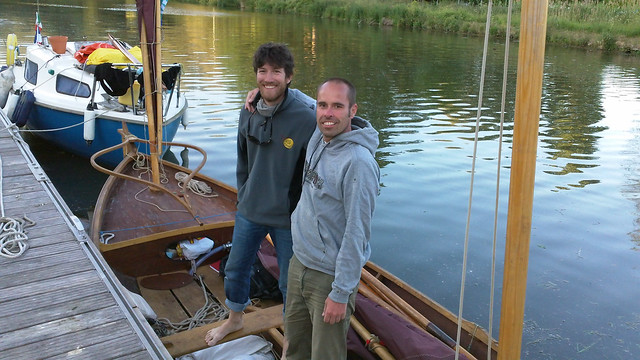
They’ve been wonderful mates in very harsh travel conditions. For now, we’ll stick to the original plan: Two rowers over a nutshell.
We row for about 35 km in ten hours, up to Fargniers, taking turns every two hours against a weak wind. We enter the Canal de la Sambre à l’Oise. We stop for the night on the banks, close to the next lock. As usual, we meet new friends: Two nice Dutch, who don’t speak English but, after seeing us very tired, are so kind to offer an excellent beer.
The next day the winds gets stronger and we can’t proceed any more than 22 km.
 We soffer and tow the boat from the bank with a lace, but eventually we enter the Canal de l’Oise à l’Aisne.
We soffer and tow the boat from the bank with a lace, but eventually we enter the Canal de l’Oise à l’Aisne.
French Canals are so many! If you want to take a look, you may find a full list here.
The wind fades off because it now blows at right angles and the trees offer us a very efficient and most appreciate shielding.
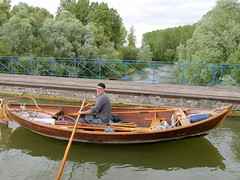 We cross the first suspended bridge, better still the first “suspended channel”: We’re rowing 15 metres over the Ailette river! Reached Guny, we sleep in a gorgeous area dedicated to sailors, and equipped with haulage slipway, bollards, etc: An example to be followed. The night is cold and windy. In the morning we decide to visit the boulangerie for a croissant and a baguette, honouring local traditions…
We cross the first suspended bridge, better still the first “suspended channel”: We’re rowing 15 metres over the Ailette river! Reached Guny, we sleep in a gorgeous area dedicated to sailors, and equipped with haulage slipway, bollards, etc: An example to be followed. The night is cold and windy. In the morning we decide to visit the boulangerie for a croissant and a baguette, honouring local traditions…
A nice cathedral stranded in nowhere, the City Hall, a school with gender-separated entrances for boys and girls, lots of silence. Wonderful!

I like this simple landscape, wild nature, hills, rare glades, untouched by man.
We keep going with the wind blowing over us, but our protector trees provide us a great barrier. Silence, trees, birds, water: And Clodia sliding.
We have no chances to get any food from local farmers, because we simply can’t find any. The wood is almost continuous and when the first shades of the evening begin to fall, we stop for the night.
From Guny, by rowing (very little sailing) and getting past many locks (we already conted more than 50 of them), we cover about 21 km to reach Pargny-Filain, where we find again a very cool mooring area equipped with electricity and water too. In the evening, looking for a bar, I see a funny sign: “Compagnie Isis”. My instinct brings me there, looking for the “mad men”, the nice and useful ones.
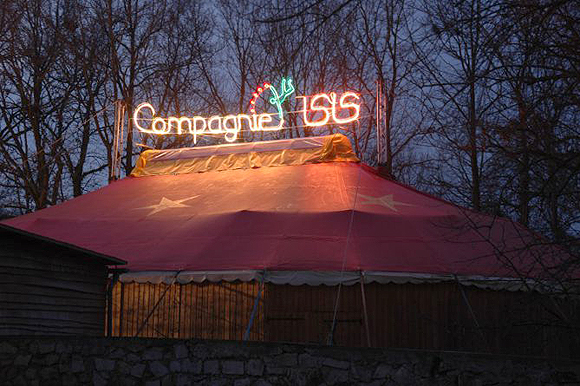
As expected, we see two big tents and we get to know that, 15 years ago, a few guys have founded a Circus Company.
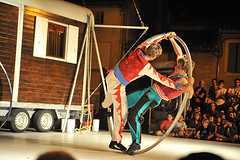 There’s also a Cambodian company getting ready to move on. They invite us to eat tasty crepes with them, in a beautiful old stone house once belonged to their philanthropist grandfather and actress mother.
There’s also a Cambodian company getting ready to move on. They invite us to eat tasty crepes with them, in a beautiful old stone house once belonged to their philanthropist grandfather and actress mother.
The two young sons, helped by their lovers and some Swedish friends, decided to give life to this little big dream.
We have a good time, talking about the future in front of a big fireplace (in the evening it still gets very cold here) and listening to great music. Tonight they invited us to watch a show: We’ll tell you more very soon.
We’re 58 km away from Reims, capital of the Champagne. We’re a bit tired, but the mood is very good indeed!
A big hug. Giacomo
P.S.: Thanks to Bea and Dieter for suggesting the title of this post
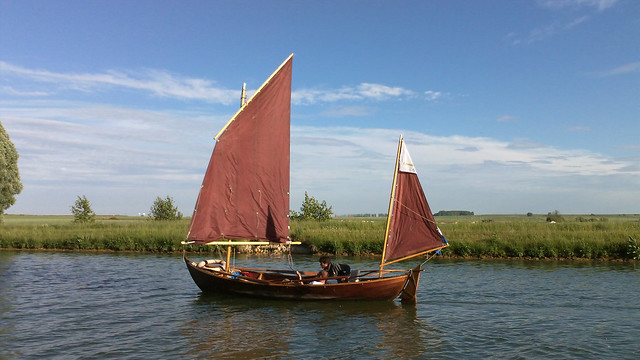
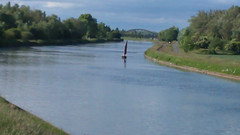 I’m back on board.
I’m back on board.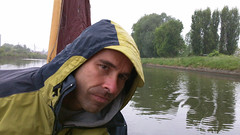 I joined them in Bethune along with Sandro, a dear friend from Venice that is now our second “sailor for a week” (or even more…)!
I joined them in Bethune along with Sandro, a dear friend from Venice that is now our second “sailor for a week” (or even more…)!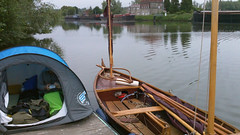 We leave from Bethune very early in the morning, heading to Douai: Sandro and I take over from Bruno and Francesco.
We leave from Bethune very early in the morning, heading to Douai: Sandro and I take over from Bruno and Francesco.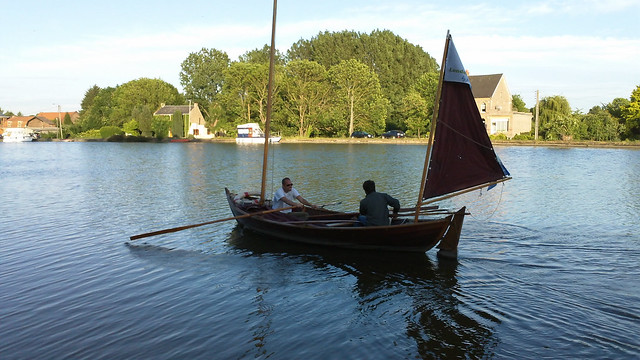
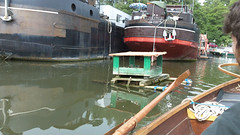 The “Grand Gabarit”, a canal running from Bethune to Douai, is rather dirty, full of dead fishes and lots of commercial boats raising annoying waves. Fine and Bruno collect two bags full of rubbish: From now on we’ll try to give our contribution to the environment. Thanks to them for this simple yet effective idea.
The “Grand Gabarit”, a canal running from Bethune to Douai, is rather dirty, full of dead fishes and lots of commercial boats raising annoying waves. Fine and Bruno collect two bags full of rubbish: From now on we’ll try to give our contribution to the environment. Thanks to them for this simple yet effective idea. After 40 km of navigation, we stop for the night in Etrun, close to the access to Saint Quentin canal. We moor in a nice basin illuminated by a mediterranean light. Here we rejoin our new English friends, waiting to offer us plenty of wine and beer. For dinner we have a tasty rice cooked by Sandro. We squeeze aboard Clodia: five people in five metres, we’re strong and happy.
After 40 km of navigation, we stop for the night in Etrun, close to the access to Saint Quentin canal. We moor in a nice basin illuminated by a mediterranean light. Here we rejoin our new English friends, waiting to offer us plenty of wine and beer. For dinner we have a tasty rice cooked by Sandro. We squeeze aboard Clodia: five people in five metres, we’re strong and happy.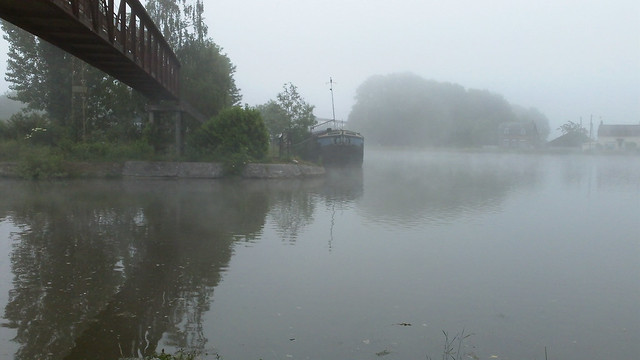
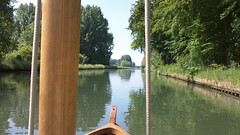 Saint Quentin canal is wonderful: There are many locks, but very well organised. Passing is easy and fast, I wish I could say the same elsewhere.
Saint Quentin canal is wonderful: There are many locks, but very well organised. Passing is easy and fast, I wish I could say the same elsewhere.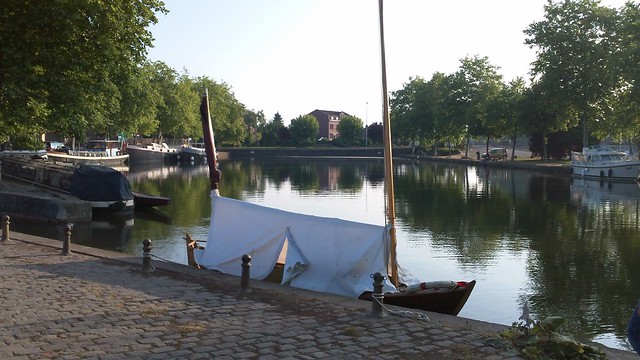
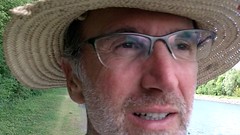 Tomorrow we’ll take the notorious “Souterrain de Riqueval”, a tunnel 5670 mt long, not aerated. To get through, we rely on the electrical ferry that goes forth and back twice a day: At 9 in the morning and at 5 in the afternoon. My travel mates are fantastic in a very tough condition. We covered 170 km in four days, very little by sail.
Tomorrow we’ll take the notorious “Souterrain de Riqueval”, a tunnel 5670 mt long, not aerated. To get through, we rely on the electrical ferry that goes forth and back twice a day: At 9 in the morning and at 5 in the afternoon. My travel mates are fantastic in a very tough condition. We covered 170 km in four days, very little by sail.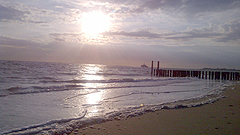 After hours from Jasmine Lane
After hours from Jasmine Lane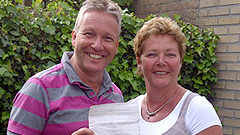 We found it, during a evening walk with our dog, at the beach of Dishoek near Vlissingen in Holland. We already visited the website Man on the River and we wish this project a lot of luck. Also thanks for the t-shirt offer.
We found it, during a evening walk with our dog, at the beach of Dishoek near Vlissingen in Holland. We already visited the website Man on the River and we wish this project a lot of luck. Also thanks for the t-shirt offer.
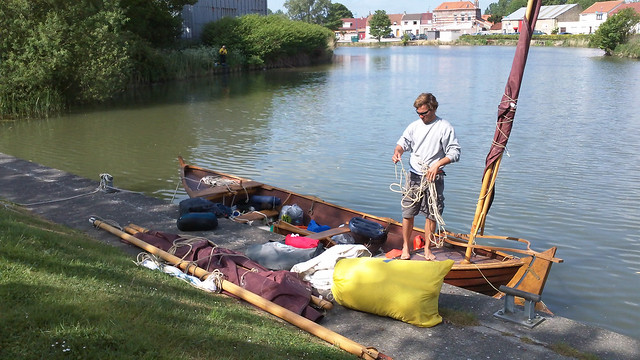
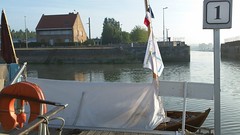
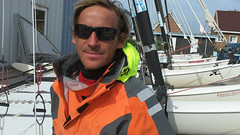
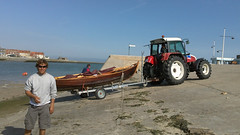 They help us without asking for anything in return or spending useless words, gentleman to gentleman. The morning after we sail for a couple of km, up to the end of the canal: Maurice, a big man with a smiling face, is waiting for us with his farm tractor. He tows Clodia out of the water for a few metres and then in the slipway beyond the lock. We’re even escorted by the police (thanks to Stefan and Jean Claude) but free once again!
They help us without asking for anything in return or spending useless words, gentleman to gentleman. The morning after we sail for a couple of km, up to the end of the canal: Maurice, a big man with a smiling face, is waiting for us with his farm tractor. He tows Clodia out of the water for a few metres and then in the slipway beyond the lock. We’re even escorted by the police (thanks to Stefan and Jean Claude) but free once again!


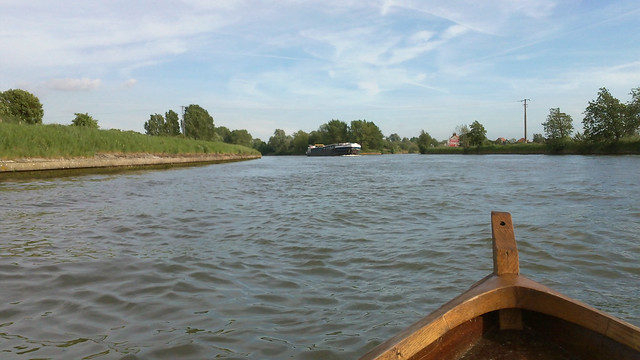
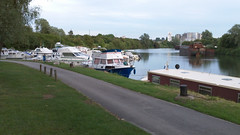 After eight hours we reach Arques, where the support boat is moored. The little port is lovely, nestled in the bend of a secondary canal and surrounded by nature. Silence and peace.
After eight hours we reach Arques, where the support boat is moored. The little port is lovely, nestled in the bend of a secondary canal and surrounded by nature. Silence and peace.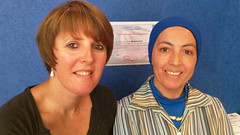 In Saint Omer, we look for help: I have to get back to Venice for my health check-up and we pay visit to a few travel agencies to get tickets with our scarce resources (Paolo will get back to Bologna too). In the
In Saint Omer, we look for help: I have to get back to Venice for my health check-up and we pay visit to a few travel agencies to get tickets with our scarce resources (Paolo will get back to Bologna too). In the 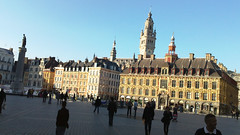 On the way back, we arranged a meeting in Lille (very nice city of the Flanders) to see the kind representatives of the VNF, the mighty company managing all the fluvial navigation network in France.
On the way back, we arranged a meeting in Lille (very nice city of the Flanders) to see the kind representatives of the VNF, the mighty company managing all the fluvial navigation network in France.
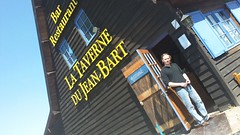
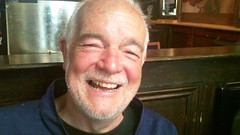 We could never have done it without the help of Chalky, a sailor friend, who escorted us all the way from Ramsgate to Gravelines.
We could never have done it without the help of Chalky, a sailor friend, who escorted us all the way from Ramsgate to Gravelines. This is the report of our day: We leave from Ramsgate at 6 o’clock after a rainy night that didn’t seem like a good omen. Chalky already offered us a good coffee.
This is the report of our day: We leave from Ramsgate at 6 o’clock after a rainy night that didn’t seem like a good omen. Chalky already offered us a good coffee. To cross the shopping lanes at 90°, Chalky asks to tow us, because the wind is contrary and he wants to get to Gravelines before 4.30 p.m. for the high tide. We can’t turn his offer down, even if it doesn’t stick to our values: We could have easily made it without any help, but not following the regulamentary 90°.
To cross the shopping lanes at 90°, Chalky asks to tow us, because the wind is contrary and he wants to get to Gravelines before 4.30 p.m. for the high tide. We can’t turn his offer down, even if it doesn’t stick to our values: We could have easily made it without any help, but not following the regulamentary 90°.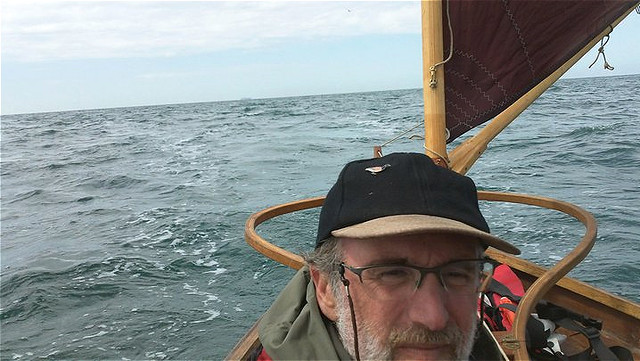
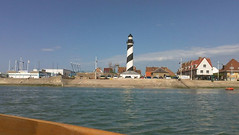
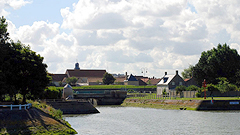 The access to the channel leading to Gravelines is a bit difficult, but we enter quite well, then we sail for the last 3 miles and dock in the wonderful Marine. Fantastic!
The access to the channel leading to Gravelines is a bit difficult, but we enter quite well, then we sail for the last 3 miles and dock in the wonderful Marine. Fantastic! We also discovered a 57 metres vessel, replica of the 18th century original, under construction: Impressive!
We also discovered a 57 metres vessel, replica of the 18th century original, under construction: Impressive! 
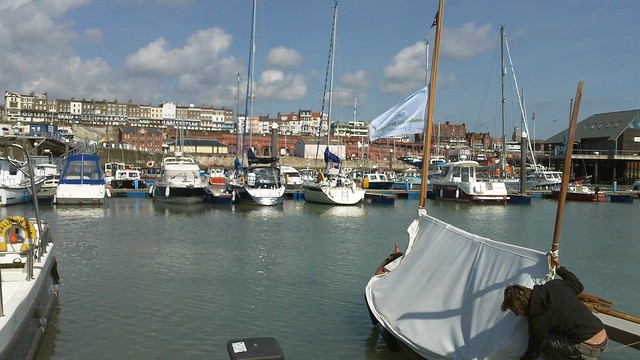
 Yesterday we towed Clodia to Ramsgate thanks to Alastair, that being a true sailor, went out of his way to help us.
Yesterday we towed Clodia to Ramsgate thanks to Alastair, that being a true sailor, went out of his way to help us.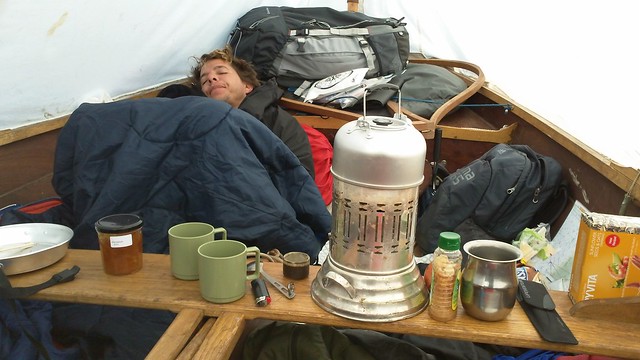
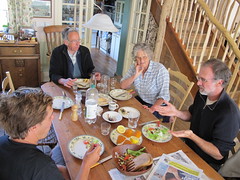 As usual, last week was full of surprises and interesting, sometimes bizarre, people.
As usual, last week was full of surprises and interesting, sometimes bizarre, people.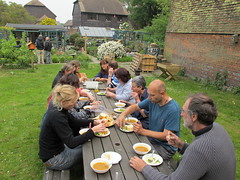 We also met the guys from the
We also met the guys from the 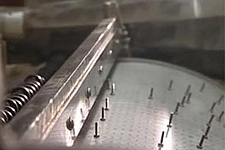 A good way to understand Henry’s talent is visiting his own house, where you can play the entrance gate. Sheer musical genius applied to simple things. I was honoured to listen to the sound of Shapsicord and other instruments: An experience that I’ll soon share with you by mounting my next video. Bear patience, my time is very little and the journey intense.
A good way to understand Henry’s talent is visiting his own house, where you can play the entrance gate. Sheer musical genius applied to simple things. I was honoured to listen to the sound of Shapsicord and other instruments: An experience that I’ll soon share with you by mounting my next video. Bear patience, my time is very little and the journey intense.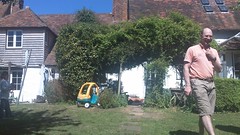 In the last few days I’ve also been so lucky to meet Alastair and Elisabetta, two friends that live in a gorgeous 16th Century house in Boughton, a few miles away from Faversham: As I previouly said, they helped us in towing Clodia to Ramsgate, which was a fantastic gift.
In the last few days I’ve also been so lucky to meet Alastair and Elisabetta, two friends that live in a gorgeous 16th Century house in Boughton, a few miles away from Faversham: As I previouly said, they helped us in towing Clodia to Ramsgate, which was a fantastic gift.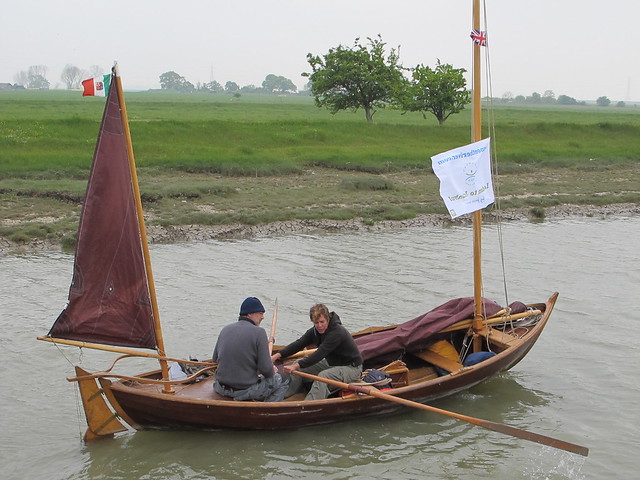
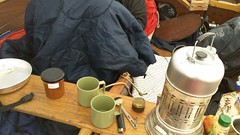 Before leaving Faversham, we received a marvelous gift from Lena: A food heater that has revealed of great help. Last night the temperature nearly reached 0°C and the wind eventually calmed down.
Before leaving Faversham, we received a marvelous gift from Lena: A food heater that has revealed of great help. Last night the temperature nearly reached 0°C and the wind eventually calmed down.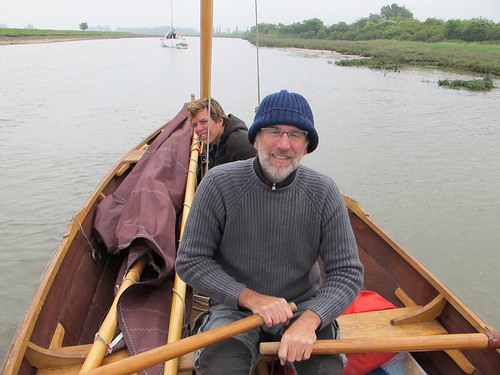 Bruno can’t wait to set sails and I understand him, I wish to leave too. Today the wind is about 10-15 knot and the weather is good, but we’re waiting for Paolo, the producer of our documentary and director (along with Nicola Pittarello) that wants to film our departure. Last year he was of great help and this year, despite the lack of funds allocated for good projects, he decided to keep following our journey because he believes in us.
Bruno can’t wait to set sails and I understand him, I wish to leave too. Today the wind is about 10-15 knot and the weather is good, but we’re waiting for Paolo, the producer of our documentary and director (along with Nicola Pittarello) that wants to film our departure. Last year he was of great help and this year, despite the lack of funds allocated for good projects, he decided to keep following our journey because he believes in us.
 On Riverside Stories
On Riverside Stories






















